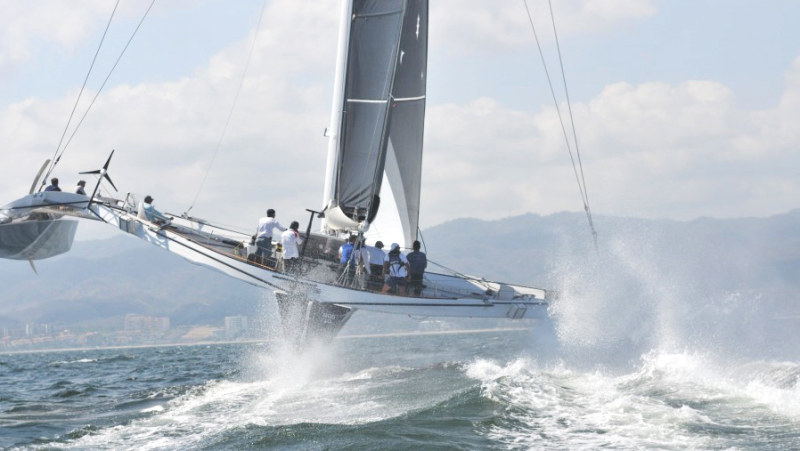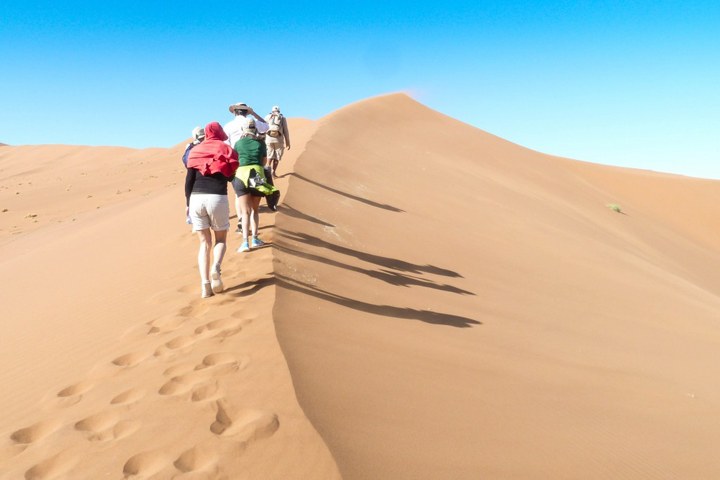
Fast on Port, Too

From time to time we get funny mail. For example, yesterday we got one, the gist of which was, "I saw the Monday ‘Lectronic video of the MOD70 Orion sailing at 30 plus knots on Banderas Bay while on starboard tack. Is she as fast on port tack?"
We’ll let the following video answer that curious question.
The trimaran was sailing in the high 20s and low 30s in the video. Notice how it wasn’t particularly windy.
By the way, Orion left Marina Riviera Nayarit a couple of days ago, which means she should comfortably make it to the San Diego YC guest dock for sundowners on Friday, and be at Clipper Yacht Harbor in Sausalito a few days after that.
Boom Boom on Beach House
April wasn’t the best month for Scott Stolnitz of the Marina del Rey-based Switch 51 Beach House.
"Our trip from Cape Town to Nambia turned out to be a 72-hour motorboat ride. But it was calm and we could see all the other vessels on AIS. Our plan was to stop in the sleepy mining town of Luderitz, refuel, then head to Walvis Bay 235 miles further north. From there we would visit the famous Sossesviev Sand Dunes.

"After a short stop at Luderitz, we took off for Walvis. Soon all hell broke loose. First, the hydraulic steering failed while sailing almost dead downwind. In retrospect, this was due to a technician in Cape Town who improperly bled the hydraulic system. Once the steering failed, we attempted a manual course correction, but the steering was now so loose that the boat couldn’t be controlled. We did an accidental gybe, and when the boom came across it broke our traveler system, the preventer system, and most importantly, sheared the back bearing right off the boom. So that was that.

"The drama of the moment was that it was blowing 25 knots and building. The main had to come down. Since we couldn’t roll it into the boom as we normally do, it had to be lowered onto the deck. As the boat was unmanageable due to the steering failure, half of the big main blew off the boat twice. The sail weighs about 200 pounds. Amazingly, Nikki and I were able to maneuver the boat so the wind would start to blow the main back onboard. After a 90-minute struggle, with the wind blowing 30 knots, we got the sail back on the boat. At this point, the hydraulic steering seemed to rehabilitate itself as a result of an air bubble finally working it’s way through the system. We re-arrived at Luderitz at around 8pm and promptly went to bed. It had been quite a day!
"Weather was becoming a potential issue, as winter is coming to the Southern Hemisphere. Fortunately, we lucked out and instead of having to blast into headwinds were blessedly able to motor 72 hours back to Cape Town. Once there, we were able to assess the full damage. The boom was broken or bent in three places. The back end and bearing, the front yolk, and the mid support all had to be replaced. Parts were ordered from Forespar in California. The really good news was that Southern Spars, the largest mast manufacturer in the southern hemisphere, is in Cape Town. They were able to perfectly straighten our mandrel! If necessary, they could have made a new one right here. We also got a newly designed mid boom roller guide section, support, and a repaired mandrel. We also got a new rear plate and outer bearing. The new bearing is much thicker and the welds are on both the inside and the back of the plate. This bearing would not have sheared off if it was as repaired. The traveller system was upgraded to a Harken system.
"What we lacked confidence in most was the hydraulic steering system, and that took about five iterations to resolve. First, it was determined that air in the system is what caused the failure. Second, Meridian Technologies took over and really went over the system. They made custom pistons for our steering rams and used a “gas/liquid” seal. Not only did they get the steering completely tight (responsive), but they managed to fix the rudder synchronization issue as well. Next, the boys from Associated Rigging took over and did a great job of repairing the boom — it’s 300 pounds! — and re-installing it. A new Tylaska main halyard shackle was installed, which has completely eliminated the twist in our 2:1 main halyard. This shackle is twice the strength of the previous one which bent in the ‘boom, boom, boom, boom’ debacle.
"With the repairs done, we headed back to Luderitz in preparation for sailing across the South Atlantic."
Latitude note: Our 63-ft catamaran Profligate was originally equipped with hydraulic steering for the two helm stations and two rudders. Somehow we survived two trips to Mexico and back, but the steering was a disaster. The rudders would ‘pizza pie’ or ‘snow plow’; the wheels would turn with no rudder response; and the hydraulic fluid would regularly erupt from the pumps. Unable to get the problem solved, we moved to the Mambo bevel box and rod system, now sold by Lewmar. We know hydraulics work on many boats, but because we were unable to get our system to work, going to the Mambo was the best thing we ever did. If nothing else, the cat now has two potentially independent steering systems.
